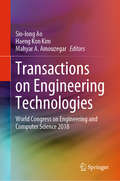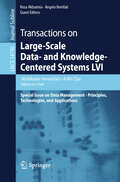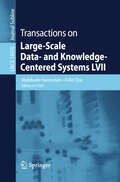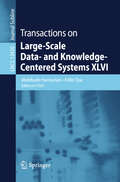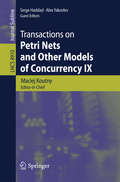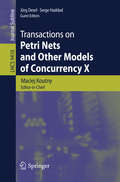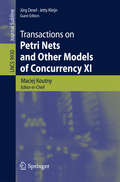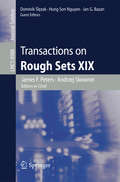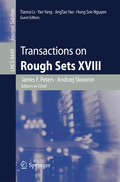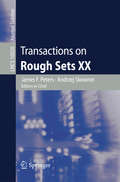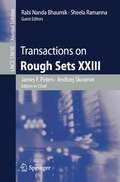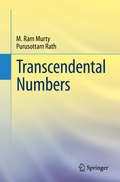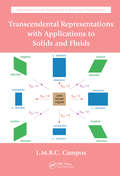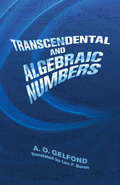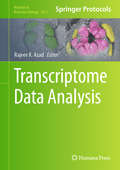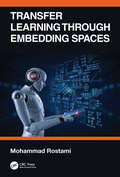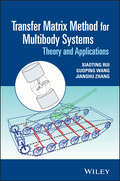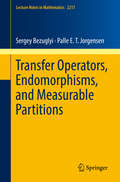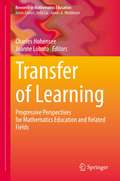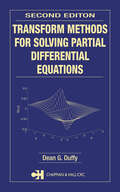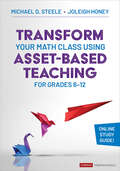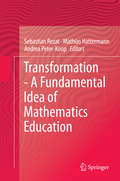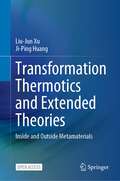- Table View
- List View
Transactions on Engineering Technologies: World Congress on Engineering and Computer Science 2018 (Lecture Notes In Electrical Engineering Ser. #275)
by Sio-Iong Ao Haeng Kon Kim Mahyar A. AmouzegarThis book features a selection of revised and extended research articles written by prominent researchers who participated in the 26th World Congress on Engineering and Computer Science (WCECS 2018), held in San Francisco, USA, on October 23–25, 2018. Topics covered include engineering mathematics, electrical engineering, communications systems, computer science, chemical engineering, systems engineering, manufacturing engineering and industrial applications. With contributions carefully chosen to represent the most cutting-edge research presented at the conference and highlighting the state of the art in engineering technologies and the physical sciences and their applications, the book is a valuable reference resource for graduate students and researchers working in these fields.
Transactions on Engineering Technologies: World Congress on Engineering and Computer Science 2019 (Lecture Notes In Electrical Engineering Ser. #275)
by Sio-Iong Ao Mahyar A. Amouzegar Haeng-Kon KimThis book contains a selection of revised and extended research articles written by prominent researchers participating in the 27th World Congress on Engineering and Computer Science (WCECS 2019) which was held in San Francisco, USA, on October 22–24, 2019. Topics covered include engineering mathematics, electrical engineering, communications systems, computer science, chemical engineering, systems engineering, manufacturing engineering, and industrial applications. With contributions carefully chosen to represent the most cutting-edge research presented during the conference, the book contains some of the state-of-the-art in engineering technologies and the physical sciences and their applications and serves as a useful reference for researchers and graduate students working in these fields.
Transactions on Large-Scale Data- and Knowledge-Centered Systems LVI: Special Issue on Data Management - Principles, Technologies, and Applications (Lecture Notes in Computer Science #14790)
by Abdelkader Hameurlain Angela Bonifati A Min Tjoa Reza AkbariniaThe LNCS journal Transactions on Large-scale Data and Knowledge-centered Systemsfocuses on data management, knowledge discovery, and knowledge processing, which are core and hot topics in computer science. Since the 1990s, the Internet has become the maindriving force behind application development in all domains. An increase in the demand forresource sharing across different sites connected through networks has led to an evolution ofdata- and knowledge-management systems from centralized systems to decentralized systemsenabling large-scale distributed applications providing high scalability. This, the 56th issue of Transactions on Large-Scale Data- and Knowledge-Centered Systems,contains five fully revised and extended papers selected from the 39th conference on DataManagement - Principles, Technologies and Applications, BDA 2023. The topics cover awide range of timely data management research topics on adaptive learning, personal datamanagement systems, topic discovery in large corpora, spatio-temporal query processing, anddata generation.
Transactions on Large-Scale Data- and Knowledge-Centered Systems LVII (Lecture Notes in Computer Science #14970)
by Abdelkader Hameurlain A Min TjoaThe LNCS journal Transactions on Large-scale Data and Knowledge-centered Systemsfocuses on data management, knowledge discovery, and knowledge processing, which arecore and hot topics in computer science. Since the 1990s, the Internet has become the maindriving force behind application development in all domains. An increase in the demand forresource sharing (e.g. computing resources, services, metadata, data sources) across differentsites connected through networks has led to an evolution of data- and knowledge-managementsystems from centralized systems to decentralized systems enabling large-scale distributedapplications providing high scalability. This, the 57th issue of Transactions on Large-scale Data and Knowledge-centered Systems,contains five fully revised selected regular papers. Topics covered include leveraging machinelearning for effective data management, access control models, reciprocal authorizations,Internet of Things, digital forensics, code similarity search, volunteered geographicinformation, and spatial data quality.
Transactions on Large-Scale Data- and Knowledge-Centered Systems XLVI (Lecture Notes in Computer Science #12410)
by Abdelkader Hameurlain A Min TjoaThe LNCS journal Transactions on Large-Scale Data- and Knowledge-Centered Systems focuses on data management, knowledge discovery, and knowledge processing, which are core and hot topics in computer science. Since the 1990s, the Internet has become the main driving force behind application development in all domains. An increase in the demand for resource sharing (e.g., computing resources, services, metadata, data sources) across different sites connected through networks has led to an evolution of data- and knowledge-management systems from centralized systems to decentralized systems enabling large-scale distributed applications providing high scalability. This, the 46th issue of Transactions on Large-Scale Data- and Knowledge-Centered Systems, contains six fully revised selected regular papers. Topics covered include an elastic framework for genomic data management, medical data cloud federations, temporal pattern mining, scalable schema discovery, load shedding, and selectivity estimation using linked Bayesian networks.
Transactions on Petri Nets and Other Models of Concurrency IX
by Serge Haddad Maciej Koutny Alex YakovlevThese Transactions publish archival papers in the broad area of Petri nets and other models of concurrency, ranging from theoretical work to tool support and industrial applications. ToPNoC issues are published as LNCS volumes, and hence are widely distributed and indexed. This Journal has its own Editorial Board which selects papers based on a rigorous two-stage refereeing process. ToPNoC contains:- Revised versions of a selection of the best papers from workshops and tutorials at the annual Petri net conferences- Special sections/issues within particular subareas (similar to those published in the Advances in Petri Nets series)- Other papers invited for publication in ToPNoC- Papers submitted directly to ToPNoC by their authorsThe 9th volume of ToPNoC contains revised and extended versions of a selection of the best workshop papers presented at the 34th International Conference on Application and Theory of Petri Nets and Concurrency (Petri Nets 2013) and the 13th International Conference on Application of Concurrency to System Design (ACSD 2013). It also contains one paper submitted directly to ToPNoC. The 8 papers cover a diverse range of topics including model checking and system verification, refinement and synthesis, foundational work on specific classes of Petri nets, and innovative applications of Petri nets and other models of concurrency. Application areas covered in this volume are: biological systems, communication protocols, business processes, distributed systems, and multi-agent systems. Thus, this volume gives a good view of ongoing concurrent systems and Petri nets research.
Transactions on Petri Nets and Other Models of Concurrency X
by Serge Haddad Maciej Koutny Jörg DeselThese Transactions publish archival papers in the broad area of Petri nets and other models of concurrency, ranging from theoretical work to tool support and industrial applications. ToPNoC issues are published as LNCS volumes, and hence are widely distributed and indexed. This Journal has its own Editorial Board which selects papers based on a rigorous two-stage refereeing process. ToPNoC contains: - Revised versions of a selection of the best papers from workshops and tutorials at the annual Petri net conferences - Special sections/issues within particular subareas (similar to those published in the Advances in Petri Nets series) - Other papers invited for publication in ToPNoC - Papers submitted directly to ToPNoC by their authors The 10th volume of ToPNoC contains revised and extended versions of a selection of the best workshop papers presented at the 35th International Conference on Application and Theory of Petri Nets and Concurrency, Petri Nets 2014, and the 14th International Conference on Application of Concurrency to System Design, ACSD 2014. It also contains one paper submitted directly to ToPNoC. The 8 papers cover a diverse range of topics including model checking and system verification, refinement, and synthesis; foundational work on specific classes of Petri nets; and innovative applications of Petri nets and other models of concurrency.
Transactions on Petri Nets and Other Models of Concurrency XI
by Maciej Koutny Jörg Desel Jetty KleijnThe 11th volume of ToPNoC contains revised and extended versions of a selection of the best workshop papers presented at the 36th International Conference on Application and Theory of Petri Nets and Concurrency, Petri Nets 2015, and the 15th International Conference on Application of Concurrency to System Design, ACSD 2014. It also contains one paper submitted directly to ToPNoC. The 16 papers cover a diverse range of topics including model checking and system verification, refinement and synthesis; foundational work on specific classes of Petri nets; and innovative applications of Petri nets and other models of concurrency. Application areas covered in this volume are: security, service composition, communication protocols, business processes, distributed systems, and multi-agent systems. Thus, this volume gives a good overview of ongoing research on concurrent systems and Petri nets.
Transactions on Rough Sets XIX
by James F. Peters Andrzej Skowron Hung Son Nguyen Dominik Ślȩzak Jan G. BazanThe LNCS journal Transactions on Rough Sets is devoted to the entire spectrum of rough sets related issues, from logical and mathematical foundations, through all aspects of rough set theory and its applications, such as data mining, knowledge discovery, and intelligent information processing, to relations between rough sets and other approaches to uncertainty, vagueness, and incompleteness, such as fuzzy sets and theory of evidence. Volume XIX in the series focuses on the current trends and advances in both the foundations and practical applications of rough sets. It contains 7 extended and revised papers originally presented at the Workshop on Rough Set Applications, RSA 2012, held in Wroclaw, Poland, in September 2012. In addition, the book features 3 contributions in the category of short surveys and monographs on the topic.
Transactions on Rough Sets XVIII (Lecture Notes in Computer Science #8449)
by James F. Peters, Andrzej Skowron, Tianrui Li, Yan Yang, JingTao Yao and Hung Son NguyenThe LNCS journal Transactions on Rough Sets is devoted to the entire spectrum of rough sets related issues, from logical and mathematical foundations, through all aspects of rough set theory and its applications, such as data mining, knowledge discovery, and intelligent information processing, to relations between rough sets and other approaches to uncertainty, vagueness, and incompleteness, such as fuzzy sets and theory of evidence.Volume XVIII includes extensions of papers from the Joint Rough Set Symposium (JRS 2012), which was held in Chengdu, China, in August 2012. The seven papers that constitute this volume deal with topics such as: rough fuzzy sets, intuitionistic fuzzy sets, multi-granulation rough sets, decision-theoretic rough sets, three-way decisions and their applications in attribute reduction, feature selection, overlapping clustering, data mining, cost-sensitive learning, face recognition, and spam filtering.
Transactions on Rough Sets XX
by James F. Peters Andrzej SkowronThe LNCS journal Transactions on Rough Sets is devoted to the entire spectrum of rough sets related issues, from logical and mathematical foundations, through all aspects of rough set theory and its applications, such as data mining, knowledge discovery, and intelligent information processing, to relations between rough sets and other approaches to uncertainty, vagueness, and incompleteness, such as fuzzy sets and theory of evidence. Volume XX in the series is a continuation of a number of research streams that have grown out of the seminal work of Zdzislaw Pawlak during the first decade of the 21st century.
Transactions on Rough Sets XXIII (Lecture Notes in Computer Science #13610)
by James F. Peters Andrzej Skowron Sheela Ramanna Rabi Nanda BhaumikThe LNCS journal Transactions on Rough Sets is devoted to the entire spectrum of rough sets related issues, from logical and mathematical foundations, through all aspects of rough set theory and its applications, such as data mining, knowledge discovery, and intelligent information processing, to relations between rough sets and other approaches to uncertainty, vagueness, and incompleteness, such as fuzzy sets and theory of evidence. Volume XXIII in the series is a continuation of a number of research streams that have grown out of the seminal work of Zdzislaw Pawlak during the first decade of the 21st century.
Transcendental Numbers
by M. Ram Murty Purusottam RathThis book provides an introduction to the topic of transcendental numbers for upper-level undergraduate and graduate students. The text is constructed to support a full course on the subject, including descriptions of both relevant theorems and their applications. While the first part of the book focuses on introducing key concepts, the second part presents more complex material, including applications of Baker's theorem, Schanuel's conjecture, and Schneider's theorem. These later chapters may be of interest to researchers interested in examining the relationship between transcendence and L-functions. Readers of this text should possess basic knowledge of complex analysis and elementary algebraic number theory.
Transcendental Representations with Applications to Solids and Fluids (Mathematics and Physics for Science and Technology)
by Luis Manuel Braga da Costa CamposBuilding on the author's previous book in the series, Complex Analysis with Applications to Flows and Fields (CRC Press, 2010), Transcendental Representations with Applications to Solids and Fluids focuses on four infinite representations: series expansions, series of fractions for meromorphic functions, infinite products for functions with infinit
Transcendental and Algebraic Numbers (Dover Books on Mathematics)
by A. O. Gelfond Leo F. BoronPrimarily an advanced study of the modern theory of transcendental and algebraic numbers, this treatment by a distinguished Soviet mathematician focuses on the theory's fundamental methods. The text also chronicles the historical development of the theory's methods and explores the connections with other problems in number theory. The problem of approximating algebraic numbers is also studied as a case in the theory of transcendental numbers.Topics include the Thue-Siegel theorem, the Hermite-Lindemann theorem on the transcendency of the exponential function, and the work of C. Siegel on the transcendency of the Bessel functions and of the solutions of other differential equations. The final chapter considers the Gelfond-Schneider theorem on the transcendency of alpha to the power beta. Each proof is prefaced by a brief discussion of its scheme, which provides a helpful guide to understanding the proof's progression.
Transcriptome Data Analysis (Methods in Molecular Biology #2812)
by Rajeev K. AzadThis detailed volume presents a comprehensive exploration of the advances in transcriptomics, with a focus on methods and pipelines for transcriptome data analysis. In addition to well-established RNA sequencing (RNA-Seq) data analysis protocols, the chapters also examine specialized pipelines, such as multi-omics data integration and analysis, gene interaction network construction, single-cell trajectory inference, detection of structural variants, application of machine learning, and more. As part of the highly successful Methods in Molecular Biology series, chapters include the kind of detailed implementation advice that leads to best results in the lab. Authoritative and practical, Transcriptome Data Analysis serves as an ideal resource for educators and researchers looking to understand new developments in the field, learn usage of the protocols for transcriptome data analysis, and implement the tools or pipelines to address relevant problemsof their interest. Chapter 4 is available open access under a Creative Commons Attribution 4.0 International License via link.springer.com.
Transfer Learning through Embedding Spaces
by Mohammad RostamiRecent progress in artificial intelligence (AI) has revolutionized our everyday life. Many AI algorithms have reached human-level performance and AI agents are replacing humans in most professions. It is predicted that this trend will continue and 30% of work activities in 60% of current occupations will be automated. This success, however, is conditioned on availability of huge annotated datasets to training AI models. Data annotation is a time-consuming and expensive task which still is being performed by human workers. Learning efficiently from less data is a next step for making AI more similar to natural intelligence. Transfer learning has been suggested a remedy to relax the need for data annotation. The core idea in transfer learning is to transfer knowledge across similar tasks and use similarities and previously learned knowledge to learn more efficiently. In this book, we provide a brief background on transfer learning and then focus on the idea of transferring knowledge through intermediate embedding spaces. The idea is to couple and relate different learning through embedding spaces that encode task-level relations and similarities. We cover various machine learning scenarios and demonstrate that this idea can be used to overcome challenges of zero-shot learning, few-shot learning, domain adaptation, continual learning, lifelong learning, and collaborative learning.
Transfer Matrix Method for Multibody Systems: Theory and Applications
by Guoping Wang Xiaoting Rui Jianshu ZhangTRANSFER MATRIX METHOD FOR MULTIBODY SYSTEMS: THEORY AND APPLICATIONS Xiaoting Rui, Guoping Wang and Jianshu Zhang - Nanjing University of Science and Technology, China Featuring a new method of multibody system dynamics, this book introduces the transfer matrix method systematically for the first time. First developed by the lead author and his research team, this method has found numerous engineering and technological applications. Readers are first introduced to fundamental concepts like the body dynamics equation, augmented operator and augmented eigenvector before going in depth into precision analysis and computations of eigenvalue problems as well as dynamic responses. The book also covers a combination of mixed methods and practical applications in multiple rocket launch systems, self-propelled artillery as well as launch dynamics of on-ship weaponry. • Comprehensively introduces a new method of analyzing multibody dynamics for engineers • Provides a logical development of the transfer matrix method as applied to the dynamics of multibody systems that consist of interconnected bodies • Features varied applications in weaponry, aeronautics, astronautics, vehicles and robotics Written by an internationally renowned author and research team with many years' experience in multibody systems Transfer Matrix Method of Multibody System and Its Applications is an advanced level text for researchers and engineers in mechanical system dynamics. It is a comprehensive reference for advanced students and researchers in the related fields of aerospace, vehicle, robotics and weaponry engineering.
Transfer Operators, Endomorphisms, and Measurable Partitions (Lecture Notes in Mathematics #2217)
by Sergey Bezuglyi Palle E. JorgensenThe subject of this book stands at the crossroads of ergodic theory and measurable dynamics. With an emphasis on irreversible systems, the text presents a framework of multi-resolutions tailored for the study of endomorphisms, beginning with a systematic look at the latter. This entails a whole new set of tools, often quite different from those used for the “easier” and well-documented case of automorphisms. Among them is the construction of a family of positive operators (transfer operators), arising naturally as a dual picture to that of endomorphisms. The setting (close to one initiated by S. Karlin in the context of stochastic processes) is motivated by a number of recent applications, including wavelets, multi-resolution analyses, dissipative dynamical systems, and quantum theory. The automorphism-endomorphism relationship has parallels in operator theory, where the distinction is between unitary operators in Hilbert space and more general classes of operators such as contractions. There is also a non-commutative version: While the study of automorphisms of von Neumann algebras dates back to von Neumann, the systematic study of their endomorphisms is more recent; together with the results in the main text, the book includes a review of recent related research papers, some by the co-authors and their collaborators.
Transfer of Learning: Progressive Perspectives for Mathematics Education and Related Fields (Research in Mathematics Education)
by Charles Hohensee Joanne LobatoThis book provides a common language for and makes connections between transfer research in mathematics education and transfer research in related fields. It generates renewed excitement for and increased visibility of transfer research, by showcasing and aggregating leading-edge research from the transfer research community. This book also helps to establish transfer as a sub-field of research within mathematics education and extends and refines alternate perspectives on the transfer of learning. The book provides an overview of current knowledge in the field as well as informs future transfer research.
Transform Methods for Solving Partial Differential Equations (Symbolic & Numeric Computation)
by Dean G. DuffyTransform methods provide a bridge between the commonly used method of separation of variables and numerical techniques for solving linear partial differential equations. While in some ways similar to separation of variables, transform methods can be effective for a wider class of problems. Even when the inverse of the transform cannot be found ana
Transform Your Math Class Using Asset-Based Teaching for Grades 6-12 (Corwin Mathematics Series)
by Michael D. Steele Joleigh HoneyFoster a love of mathematics by creating a more inclusive and empowering learning environment through asset-based teaching! An asset-based perspective on math education means starting with what students already know instead of focusing on what’s missing. This approach elevates student thinking and reasoning skills. In this way, educators acknowledge that all students bring prior experiences, strengths, talents, and resources to the learning process and can contribute meaningfully in an authentic learning environment. Transform Your Math Class Using Asset-Based Teaching for Grades 6-12 provides insight into asset-based perspectives in mathematics education to create an environment where all students feel valued and capable of being doers of mathematics. In the book, Michael Steele and Joleigh Honey highlight the importance of using language, instructional routines, and systemic structure that positively impact student engagement, their math identity, and ultimately their outcomes. Providing a wealth of knowledge and practical strategies that can be used to transform math classrooms into inclusive, supportive, and empowering learning environments, this book: Introduces an asset-based perspective that focuses on students′ strengths, assets, and potential to learn mathematics Includes a variety of frameworks and tools that teachers can use to build and grow their sense of asset-based perspectives Offers strategies for promoting a growth mindset in mathematics, encouraging productive struggle in math, and promoting equitable math instruction Supports teachers in reflecting on their decisions, self-awareness, and self-management Includes a companion online study guide to support teachers individually or as part of a professional learning community Adopting asset-based perspectives is about movement over time, not about flipping a switch. This book paves the path for an asset-based journey that ultimately helps to transform our math classrooms and advance all students’ learning and development.
Transform Your Math Class Using Asset-Based Teaching for Grades 6-12 (Corwin Mathematics Series)
by Michael D. Steele Joleigh HoneyFoster a love of mathematics by creating a more inclusive and empowering learning environment through asset-based teaching! An asset-based perspective on math education means starting with what students already know instead of focusing on what’s missing. This approach elevates student thinking and reasoning skills. In this way, educators acknowledge that all students bring prior experiences, strengths, talents, and resources to the learning process and can contribute meaningfully in an authentic learning environment. Transform Your Math Class Using Asset-Based Teaching for Grades 6-12 provides insight into asset-based perspectives in mathematics education to create an environment where all students feel valued and capable of being doers of mathematics. In the book, Michael Steele and Joleigh Honey highlight the importance of using language, instructional routines, and systemic structure that positively impact student engagement, their math identity, and ultimately their outcomes. Providing a wealth of knowledge and practical strategies that can be used to transform math classrooms into inclusive, supportive, and empowering learning environments, this book: Introduces an asset-based perspective that focuses on students′ strengths, assets, and potential to learn mathematics Includes a variety of frameworks and tools that teachers can use to build and grow their sense of asset-based perspectives Offers strategies for promoting a growth mindset in mathematics, encouraging productive struggle in math, and promoting equitable math instruction Supports teachers in reflecting on their decisions, self-awareness, and self-management Includes a companion online study guide to support teachers individually or as part of a professional learning community Adopting asset-based perspectives is about movement over time, not about flipping a switch. This book paves the path for an asset-based journey that ultimately helps to transform our math classrooms and advance all students’ learning and development.
Transformation - A Fundamental Idea of Mathematics Education
by Sebastian Rezat Mathias Hattermann Andrea Peter-KoopThe diversity of research domains and theories in the field of mathematics education has been a permanent subject of discussions from the origins of the discipline up to the present. On the one hand the diversity is regarded as a resource for rich scientific development on the other hand it gives rise to the often repeated criticism of the discipline's lack of focus and identity. As one way of focusing on core issues of the discipline the book seeks to open up a discussion about fundamental ideas in the field of mathematics education that permeate different research domains and perspectives. The book addresses transformation as one fundamental idea in mathematics education and examines it from different perspectives. Transformations are related to knowledge, related to signs and representations of mathematics, related to concepts and ideas, and related to instruments for the learning of mathematics. The book seeks to answer the following questions: What do we know about transformations in the different domains? What kinds of transformations are crucial? How is transformation in each case conceptualized?
Transformation Thermotics and Extended Theories: Inside and Outside Metamaterials
by Ji-Ping Huang Liu-Jun XuThis open access book describes the theory of transformation thermotics and its extended theories for the active control of macroscopic thermal phenomena of artificial systems, which is in sharp contrast to classical thermodynamics comprising the four thermodynamic laws for the passive description of macroscopic thermal phenomena of natural systems. This monograph consists of two parts, i.e., inside and outside metamaterials, and covers the basic concepts and mathematical methods, which are necessary to understand the thermal problems extensively investigated in physics, but also in other disciplines of engineering and materials. The analyses rely on models solved by analytical techniques accompanied by computer simulations and laboratory experiments. This monograph can not only be a bridge linking three first-class disciplines, i.e., physics, thermophysics, and materials science, but also contribute to interdisciplinary development.
